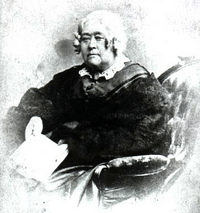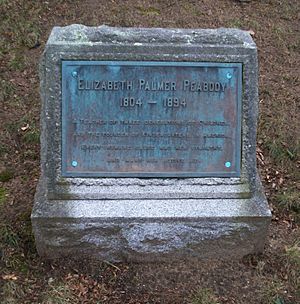Elizabeth Peabody facts for kids
Quick facts for kids
Elizabeth Palmer
|
|
|---|---|
 |
|
| Born | 16 May 1804 Billerica, Massachusetts, U.S.
|
| Died | 3 January 1894 (aged 89) |
| Education | Tutored in Greek by Ralph Waldo Emerson |
| Occupation | Teacher Writer/Editor |
| Parent(s) | Nathaniel Peabody, Elizabeth "Eliza" Palmer |
Elizabeth Palmer Peabody (May 16, 1804 – January 3, 1894) was an important American educator. She is famous for opening the very first English-speaking kindergarten in the United States. Long before many others, Elizabeth believed that children learn best through play. She thought playing was super important for their growth and education.
Elizabeth also helped translate a Buddhist scripture into English. This was the first time a Buddhist text was available in English, published in 1844.
Contents
Early Life and Education
Elizabeth Palmer Peabody was born in Billerica, Massachusetts, on May 16, 1804. Her father, Nathaniel Peabody, was a doctor. Her mother was Elizabeth Palmer. Elizabeth spent her early years growing up in Salem, Massachusetts.
A Career in Teaching and Writing
After 1822, Elizabeth lived mostly in Boston. There, she worked as a teacher. She also became a writer and a key person in the Transcendentalist movement. This was a group of thinkers who believed in the goodness of people and nature. They also thought that people could find truth through their own feelings and intuition.
From 1834 to 1835, Elizabeth worked as an assistant teacher. She helped Amos Bronson Alcott at his special Temple School in Boston. After this school closed, Elizabeth wrote a book called Record of a School. This book explained how the school worked and Alcott's ideas about teaching young children. His ideas were based on German teaching methods.
Her Special Bookstore
Later, Elizabeth opened her own bookstore in Boston. It was called Elizabeth Palmer Peabody's West Street Bookstore. This store was open from about 1840 to 1852.
Her bookstore was more than just a place to buy books. It was a meeting spot for important discussions. These talks were called "Conversations" and were organized by Margaret Fuller. The first meeting for women happened on November 6, 1839. People discussed many different topics. These included art, history, myths, books, and nature. Margaret Fuller led these talks. She wanted to help women answer big questions like, "What were we born to do?" and "How can we do it?" Many women who fought for women's rights joined these discussions.
The bookstore also had a large library. It offered hundreds of books in German, French, Spanish, Italian, and English. Some of the books included:
- Letters by Abigail Adams
- Fairy Legends by Thomas Crofton Croker
- Nathan der Weise by Gotthold Ephraim Lessing
- Our Village by Mary Russell Mitford
- Phantasmion by Sara Coleridge
In 1852, the bookstore closed. The Transcendentalist movement was changing, and the bookstore was not making enough money. In 2011, the building where her bookstore was located became a special Boston Landmark.
Working on The Dial Magazine
For a while, Elizabeth Peabody managed the business side of The Dial. This was the main magazine for the Transcendentalists. In 1843, she noticed that the magazine was not earning enough money to cover printing costs. It only had a little over 200 subscribers.
In 1844, the magazine published something very special. It was Elizabeth's translation of part of the Lotus Sutra. This was a Buddhist scripture. It was the first time this text was available in English. The magazine stopped publishing shortly after, in April 1844.
Bringing Kindergartens to America
Elizabeth Peabody opened her own kindergarten in 1860. At that time, formal schools for children under six were mostly found in Germany. Elizabeth was very interested in the teaching ideas of Friedrich Fröbel. He was a German educator who created the kindergarten concept. She learned more about his methods after meeting one of his students, Margarethe Schurz, in 1859.
In 1867, Elizabeth even traveled to Germany. She wanted to study Fröbel's teachings even more closely. Through her own kindergarten and by editing the Kindergarten Messenger magazine (1873–1877), Elizabeth helped make kindergarten a normal part of American education. She also wrote many books to support this idea.
Her influence was huge. In 1897, a statement was sent to Congress to support free kindergartens. It said that kindergartens help children from ages 4 to 6. They teach kids to use their hands and eyes. They also help children learn good habits like cleanliness, politeness, and self-control. Kindergartens teach about numbers and shapes too. The statement said these valuable lessons would help establish kindergartens in all city schools.
Other Important Activities
Elizabeth Peabody had a strong background in history and literature. She could read ten different languages! In 1840, she also opened her bookstore. There, she hosted Margaret Fuller's "Conversations." She also published books by famous writers like Nathaniel Hawthorne. Her store also published the magazines The Dial and Æsthetic Papers.
Elizabeth was a strong supporter of ending slavery. She also believed in Transcendentalism. On top of all this, she spent decades working for the rights of the Paiute Native Americans.
Personal Life and Legacy
Elizabeth had two famous sisters. One was the painter Sophia Peabody Hawthorne, who was married to the writer Nathaniel Hawthorne. Her other sister was the writer Mary Tyler Peabody Mann, who was married to the educator Horace Mann.
Elizabeth Peabody passed away on January 3, 1894, when she was 89 years old. She is buried at Sleepy Hollow Cemetery in Concord, Massachusetts.
Elizabeth published many important works, including:
- The Polish-American System of Chronology (1852)
- Kindergarten Culture (1870)
- Kindergarten in Italy (1872)
- Reminiscences of Rev. Wm Ellery Channing, D.D. (1880)
- Letters to Kindergarteners (1886)
- Last Evening with Allston, and other Papers (1887)
- Lectures in the Training Schools for Kindergartners (1888)
See also
 In Spanish: Elizabeth Peabody para niños
In Spanish: Elizabeth Peabody para niños



